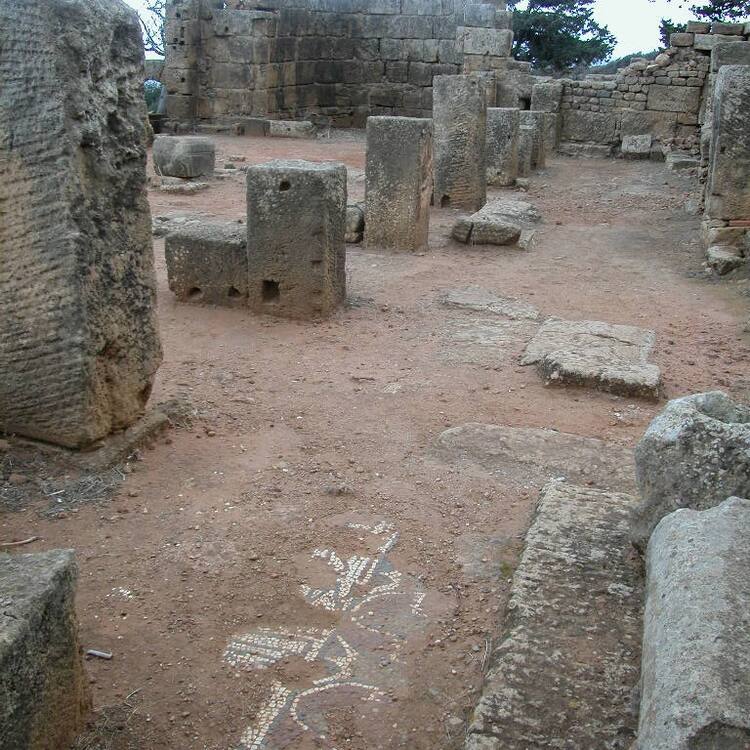Tipasa
Tipasa
On the shores of the Mediterranean, Tipasa was an ancient Punic trading-post conquered by Rome and turned into a strategic base for the conquest of the kingdoms of Mauritania. It comprises a unique group of Phoenician, Roman, palaeochristian and Byzantine ruins alongside indigenous monuments such as the Kbor er Roumia, the great royal mausoleum of Mauretania.
Description is available under license CC-BY-SA IGO 3.0
Tipasa
Sur les rives de la Méditerranée, Tipasa, ancien comptoir punique, fut occupé par Rome, qui en fit une base stratégique pour la conquête des royaumes mauritaniens. Il comprend un ensemble unique de vestiges phéniciens, romains, paléochrétiens et byzantins, voisinant avec des monuments autochtones, tel le Kbor er Roumia, grand mausolée royal de Maurétanie.
Description is available under license CC-BY-SA IGO 3.0
تيبازا
تقع تيبازا على ضفاف البحر المتوسط وهي مركز تجاري بوني (قرطاجي) قديم. احتلّها الرومان وجعلوها قاعدة استراتيجية لفتح الممالك الموريتانية. تشمل تيبازا مجموعة فريدة من الآثار الفينيقية والرومانية والمسيحية القديمة والبيزنطية التي تتجاور مع النصب المحلية مثل قبر الرومية وهو الضريح الموريتاني الملكي الكبير.
source: UNESCO/CPE
Description is available under license CC-BY-SA IGO 3.0
提帕萨
提帕萨位于地中海海滨,原是古罗马统治下古迦太基人的贸易港,后成为征服毛利塔尼亚王国的战略基地。该遗址不仅有一系列腓尼基人、罗马人、古基督教和拜占庭时期的独特建筑群遗迹,还有当地的古迹,如宏伟的毛里塔尼亚皇家陵墓——克博·埃尔·罗米亚(Kbor er Roumia)。
source: UNESCO/CPE
Description is available under license CC-BY-SA IGO 3.0
Древний город Типаса
Находящаяся на средиземноморском побережье Типаса была древним пуническим торговым пунктом, захваченным римлянами и преобразованным в стратегическую базу для завоевания царств Мавритании. Здесь находится уникальная группа руин финикийского, древнеримского, раннехристианского, византийского происхождения, а также местные памятники, такие как Кбор-эр-Румиа и большой мавзолей царей Мавритании.
source: UNESCO/CPE
Description is available under license CC-BY-SA IGO 3.0
Tipasa
Situada en la costa del Mediterráneo, Tipasa fue una factoría cartaginesa conquistada por Roma, que la transformó en base estratégica para la conquista de los reinos mauritanos. El sitio posee un conjunto único en su género de vestigios fenicios, romanos, paleocristianos y bizantinos, así como monumentos autóctonos, entre los que figura el gran mausoleo real de Mauritania (Kbor er Rumia).
source: UNESCO/CPE
Description is available under license CC-BY-SA IGO 3.0
ティパサ
source: NFUAJ
Tipasa
Aan de oevers van de Middellandse Zee ligt Tipasa, een oude Punische handelspost veroverd door Rome. De Romeinen vormden de stad om tot een strategische uitvalsbasis voor de verovering van de koninkrijken van Mauritanië. Tipasa bestaat uit een unieke groep van Fenicische, Romeinse, paleochristelijke en Byzantijnse ruïnes met daarnaast ook inheemse monumenten, zoals de Kbor er Roumia, het grote koninklijke mausoleum van Mauritanië. Tipasa is een bundeling van de meest bijzondere archeologische complexen van de Maghreb. De stad is erg belangrijk voor de studie naar contacten tussen inheemse beschavingen en de kolonisatiegolven in de periode van de 6e eeuw voor tot de 6e eeuw na Christus.
Source: unesco.nl
Outstanding Universal Value
Brief synthesis
Tipasa is located 70 km west of Algiers. It is a serial property comprising three sites: two archaeological parks located in the vicinity of the present urban complex and the Royal Mauritanian Mausoleum, on the west Sahel plateau of Algiers, at 11 km south-east of Tipasa.
The archaeological site of Tipasa regroups one of the most extraordinary archaeological complexes of the Maghreb, and perhaps one which is most significant to the study of the contacts between the indigenous civilizations and the different waves of colonization from the 6th century B.C. to the 6th century A.D. This coastal city was first a Carthaginian trading centre, whose necropolis is one of the oldest and one of the most extensive of the Punic world (6th to 2nd century B.C.). During this period, Tipasa played the role of a maritime port of call, a place for commercial exchanges with the indigenous population. Numerous necropolis testify to the very varied types of burial and funerary practices that bear witness to the multicultural exchange of influences dating back to protohistoric times. The monumental, circular funerary building, called the Royal Mauritanian Mausoleum, associates a local architectural tradition of the basina type, to a style of stepped truncated roof covering, the result of the different contributions, notably Hellenistic and Pharaonic.
The Roman period is marked by a prestigious ensemble of buildings, comprising very diversified architectural typologies. From the 3rd to the 4th centuries A.D. a striking increase in Christianity is demonstrated by the multitude of religious buildings. Some are decorated with high quality mosaic pavings, illustrating scenes from daily life, or geometric patterns. The Vandal invasion of the 430's did not mark the definitive end of prosperity of Tipasa, but the town, reconquered by the Byzantines in 531, gradually fell into decline from the 6th century.
Criterion (iii): Tipasa bears exceptional testimony to the Punic and Roman civilizations now disappeared.
Criterion (iv): The architectural and archaeological vestiges of Tipasa reflect in a significant manner the contacts between the indigenous civilizations and the Punic and Roman waves of colonization between the 6th century B.C. and the 6th century A.D.
Integrity
The boundary for the three sites has been clarified and approved by the World Heritage Committee (Decision 33 COM 8D, 2009). It includes the ensemble of vestiges that bear witness to the exceptional town-planning, architectural, historic and archaeological values of the property. The property is vulnerable due to the impact from urban development, unregulated tourism and population growth.
Authenticity
The town-planning and architectural attributes, the decoration and construction materials, all retain their original aspect that express the values, as defined at the time of inscription of the property. However, they are vulnerable through lack of conservation, encroachment of the vegetation, illegal grazing and uncontrolled visitor access.
Protection and management requirements
The legal and management framework of this property includes Laws 90-30 (regional law), 98-04 (concerning protection of cultural heritage), the Permanent Safeguarding and Presentation Plan of the site (PPSMV), the Ground Occupation Plan approved by the communal assembly of Tipasa (POS) and the Protection and Presentation Plan of archaeological sites and their buffer zone (PPMVSA), under preparation codified by executive decree N° 324-2003. A new establishment, the Office of Management and Exploitation of Cultural Properties, in coordination with the Directorate for Culture of the Wilaya (province) now manages the archaeological sites of Tipasa.


